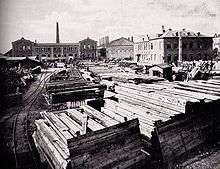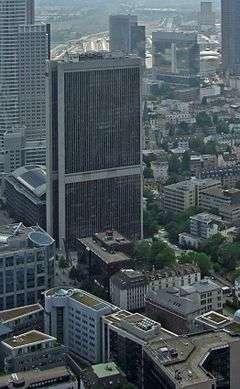Philipp Holzmann
Philipp Holzmann AG was a German construction company based in Frankfurt am Main.
 | |
| Industry | Construction |
|---|---|
| Fate | Liquidation |
| Founded | 1849 |
| Defunct | 2002 |
| Headquarters | Frankfurt am Main, Germany |
Key people | Johann Philipp Holzmann, founder |
| Website | philipp-holzmann |
History


Early years
The company was founded in 1849 by Johann Philipp Holzmann (1805-1870) at Sprendlingen in present-day Dreieich near Frankfurt am Main as Philipp Holzmann & Cie. Initially, the former sawmill company was concentrating on the supply of ties for railway construction, but then began to expand into building construction and civil engineering. In 1856, the headquarters moved to Frankfurt where in the late 19th century the company experienced rapid growth.
The first large building contract to be finished was the opera house completed in 1880,[1] followed by the central station in Frankfurt am Main completed in 1888[1] and the Amsterdam Centraal railway station in 1889.[1] Holzmann also built the original Reichstag building completed in 1894,[2] the Hamburg city hall completed in 1897 and several railway projects in East Africa and Asia, especially the Bagdadbahn built from 1903 which incorporates the Istanbul Haydarpaşa railway station finished in 1908, as well as the Varda Viaduct at Taurus Mountains in southern Turkey completed in 1916.[1] Furthermore, the company participated in the construction of the Elbe Tunnel of 1911[1] and the Hindenburgdamm completed in 1927,[1] and also the modernist Riederwald housing estate in Frankfurt.[3]
In 1917, Philipp Holzmann & Cie merged with the Internationale Baugesellschaft and became the publicly traded Philipp Holzmann Aktiengesellschaft. In 1938, the company had 20,800 employees[4] and contributed to several major building projects like the new Reich Chancellery in Berlin, the Nazi party rally grounds in Nürnberg, the Prora complex as well as the Westwall and numerous sections of the Reichsautobahn. In World War II, Holzmann constructed large parts of the Atlantic Wall by order of the Organisation Todt.[5]
Post-war years
In the post-war period, the company soon recovered with the rebuilding of Frankfurt, the airport and several public infrastructure projects. Post-war projects included the General Rafael Urdaneta Bridge in Venezuela completed in 1962,[6] the AfE-Turm in Frankfurt completed in 1972,[7] the Westend Gate in Frankfurt completed in 1976,[8] the Eurotower in Frankfurt completed in 1977[9] and the Silberturm in Frankfurt completed in 1978.[10] These projects enabled Holzmann to expand into the United States and in 1979 it acquired J.A. Jones Construction, a major US contractor.[11]
More recent major projects involving Holzmann included the Frankfurter Büro Center in Frankfurt completed in 1980,[12] the Eurotheum in Frankfurt completed in 1999,[13] the Main Tower in Frankfurt completed in 2000,[14] the Trianon in Frankfurt completed in 2003[15] and the Western Scheldt Tunnel in the Netherlands also completed in 2003.[16]
Decline
At its peak in 1994, the company had 43,000 employees and was with a revenue of 13.1 billion DM the largest German construction company. Despite public efforts for a recapitalization, the company filed for insolvency in 1999 and was finally liquidated in 2002.[2]
References
- Groß, p. 50
- "Germany Fails in Effort To Keep Builder Afloat". 24 November 1999. Retrieved 31 March 2013.
- "Chronik von Riederwald". Retrieved 31 March 2013.
- Fiedler, Martin (1999b). "Die 100 größten Unternehmen von 1938 - ein Nachtrag". Zeitschrift für Unternehmensgeschichte (in German). Munich: Verlag C.H. Beck. 2: 235–242.
- Pohl, p. 252
- General Rafael Urdaneta Bridge at Structurae database
- AfE-Turm at Structurae database
- Westend Gate at Structurae database
- Eurotower at Structurae database
- Silberturm at Structurae database
- Building for tomorrow: global enterprise and the U.S. construction industry, National Research Council (U.S.), 1988 p. 82
- Frankfurter Büro Center at Structurae database
- Eurotheum at Structurae database
- Main Tower at Structurae database
- Trianon at Structurae database
- Western Scheldt Tunnel at Structurae database
Sources
- Groß, Lothar (2012). Made in Germany: Deutschlands Wirtschaftsgeschichte von der Industralisierung bis heute Band 1: 1800 - 1945. Boos on demand. ISBN 978-3-8482-1042-8.
- Pohl, Manfred (1999). Philipp Holzmann: Geschichte eines Bauunternehmens 1849 - 1999. C.H. Beck. ISBN 978-3406453397.
External links
- Former official Philipp Holzmann website
- Documents and clippings about Philipp Holzmann in the 20th Century Press Archives of the ZBW
| Wikimedia Commons has media related to Philipp Holzmann. |